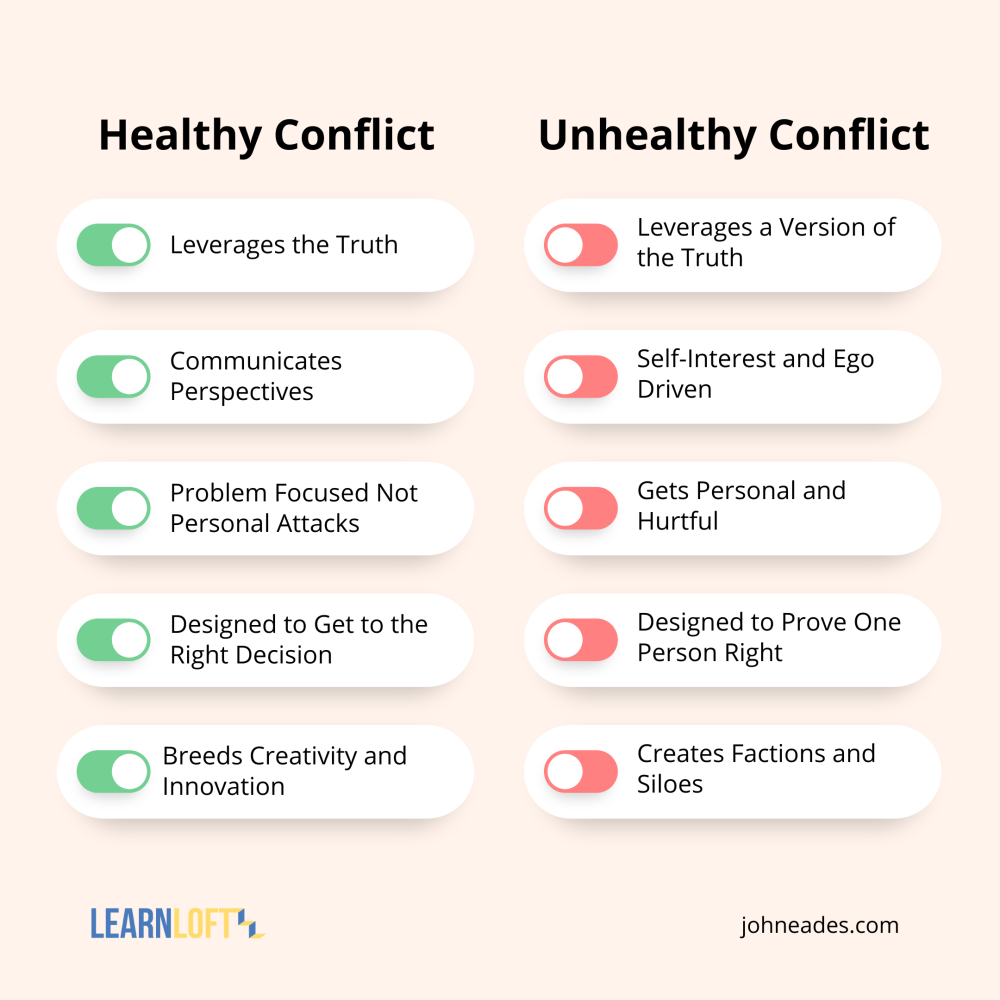Comments
- No comments found

It doesn't take a Ph.D. to figure out that some groups of people perform better than others.
Not only do high-performing teams produce better results, but their team members have a sense of meaning, belonging, and achievement.
Traditional thinking would have you believe those teams have more talent than others. While talent could undoubtedly be a part of the equation, the secret ingredient is conflict.
See, most leaders avoid conflict because they think of it as harmful. The reality is that all conflict isn't negative, and the right kind of conflict will propel a team to new heights.
Conflict, by definition, is an active disagreement between people with opposing opinions or principles. Its entomology comes from the Latin word "Con" meaning together, and "Fligere" meaning to strike. While the definition and entomology portray a negative picture, conflict can be a powerful method of getting the best answer and bringing out the best in people.
Working with leaders and teams for over a decade, I have found that there are two types of conflict on a team."

Healthy Conflict: Healthy conflict leverages the truth, communicates perspectives, and allows two or more people to wrestle down the best path forward. When healthy conflict occurs in decision-making, the sole purpose is to get to the right decision, not for one person to be right. Healthy conflict is not personal; it's problem and solution-focused. Great leaders and teams that understand the power of healthy conflict welcome it. Instead of blowing it out the moment it arises, great leaders ignite the fire because it breeds creativity, innovation, and challenges thinking.
Healthy conflict ignites teamwork. Unhealthy conflict extinguishes teamwork.
Unhealthy Conflict: Unhealthy conflict agitates, annoys, and proves one person is right and the other person is wrong. Often both parties leave the interaction feeling hurt and move further away from each other emotionally and mentally. Unhealthy conflict gets personal and forgoes the desire to help move the team or person forward at the expense of self-interest or ego. Leaders must stomp out unhealthy conflict the moment it arises as it grows like a weed and can infiltrate a team quickly.
Research indicates that an example of healthy conflict would be centered around a task. These conflicts may be beneficial for team performance, whereas unhealthy conflicts, such as relationship conflicts, are associated with negative team performance.
Peoplehum defines conflict management as the practice of being able to identify and manage conflicts sensibly, fairly, and efficiently. While it sounds simple, anyone who has ever had kids, been married, or led a team knows how difficult these skills can be.
However, instead of immediately focusing on the steps to effective conflict management, there is a more important variable to consider: speed. For example, research indicates that performance on teams was positive when the conflict was actively managed and negative when it was passively managed.
Healthy conflict starts with the leader before it gets to the team.
All great leaders recognize that healthy conflict starts with the leader before it gets to the team. The team will mimic their behavior if they swiftly manage conflict by instigating, engaging, or managing it.
Take Kelly, a Director at a high-growth company, as an example. Tasked with turning around a low-performing team, it came to her attention that two team members were making personal attacks both privately and publicly. Instead of hoping the problem would disappear, she scheduled a meeting with everyone involved, including HR, and addressed the conflict directly.
"Personal attacks and one-upping each other isn't tolerated on this team. You certainly don't have to be friends, but you must maintain respect for each other, or neither of you will be part of this team anymore. That standard goes for me as well. If I ever engage in personal attacks, I expect you to call me out."
Unhealthy conflict crushes team culture and performance.
There is no doubt Kelsey was direct and courageous, but she knew the consequence of meeting unhealthy conflict slowly was the creation of factions and siloes. Once an organization or team's siloes build walls, it's only a matter of time that culture and performance begin to erode.
If you lead a team, you might be thinking, this sounds good, but there is no way this type of healthy conflict will work on my team. Instead of assuming it won’t, try to embrace the following:
Establish a shared goal - Where is your team going, and what are they working every day to accomplish
Ensure everyone is committed to the achievement of the shared goal - It’s one thing to have a goal, it’s another thing for each team member to be committed to achieving it.
Instigate, engage, and manage conflict between team members - Invite each team member to embrace courage and be vulnerable with each other.
Agree that debate doesn’t mean the decision - Debate doesn’t mean the decision. Ray Dalio has a great principle that leaders should rely on; “Make sure people don’t confuse the right to complain, give advice, and openly debate with the right to make decisions.”
Conflict is the secret ingredient to propel your team to new heights. However, it can also be the ingredient that will demoralize your team and have solid team members quit. The only question that remains is will you be the kind of leader who invites healthy conflict but shuts down unhealthy conflict?
John is the CEO of LearnLoft, author of, F.M.L. Standing Out & Being a Leader and host of the 'Follow My Lead' Podcast. He writes or has been featured on Inc.com, LinkedIn Pulse, TrainingIndustry.com, eLearningIndustry.com, CNBC Money, and more. John completed his education at the University of Maryland College.
Leave your comments
Post comment as a guest